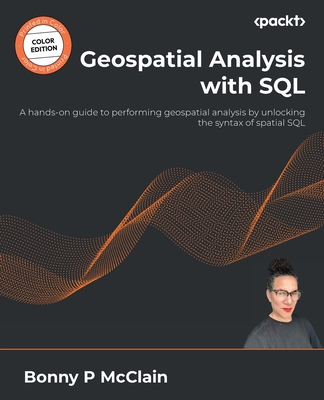Geospatial Analysis with SQL: A hands-on guide to performing geospatial analysis by unlocking the syntax of spatial SQL

Geospatial Analysis with SQL: A hands-on guide to performing geospatial analysis by unlocking the syntax of spatial SQL
Key Features: Follow along with actionable instructions with this practical guide Become well-versed in advanced spatial modeling and machine learning techniques Learn best practices for performing spatial analysis from an expert spatial data analyst
Book Description: Geospatial analysis is industry agnostic and a powerful tool for answering location questions. Combined with the power of SQL, developers and analysts worldwide rely on database integration to solve real-world spatial problems. This book introduces skills to help you detect and quantify patterns in datasets through data exploration, visualization, data engineering, and the application of analysis and spatial techniques. You will begin by exploring the fundamentals of geospatial analysis where you'll learn about the importance of geospatial analysis and how location information enhances data exploration. Walter Tobler's second law of geography states, "the phenomenon external to a geographic area of interest affects what goes on inside." This quote will be the framework of the geospatial questions we will explore. You'll then observe the framework of geospatial analysis using SQL while learning to create spatial databases and SQL queries and functions. By the end of this book, you will have an expanded toolbox of analytic skills such as PostGIS and QGIS to explore data questions and analysis of spatial information.
What You Will Learn: Understand geospatial fundamentals as a basis for learning spatial SQL Generate point, line, and polygon data with SQL Use spatial data types to abstract and encapsulate spatial structures Work with open source GIS combined with plug-ins Visualize spatial data and expand QGIS functionality with Postgres Apply location data to leverage spatial analytics Perform single-layer and multiple-layer spatial analyses
Who this book is for: This book is for anyone looking to leverage their SQL knowledge to perform geospatial analysis. GIS analysts, data analysts, and data scientists with a basic understanding of both geospatial analysis and SQL will find this book useful.
PRP: 371.92 Lei
Acesta este Prețul Recomandat de Producător. Prețul de vânzare al produsului este afișat mai jos.
297.54Lei
297.54Lei
371.92 LeiLivrare in 2-4 saptamani
Descrierea produsului
Key Features: Follow along with actionable instructions with this practical guide Become well-versed in advanced spatial modeling and machine learning techniques Learn best practices for performing spatial analysis from an expert spatial data analyst
Book Description: Geospatial analysis is industry agnostic and a powerful tool for answering location questions. Combined with the power of SQL, developers and analysts worldwide rely on database integration to solve real-world spatial problems. This book introduces skills to help you detect and quantify patterns in datasets through data exploration, visualization, data engineering, and the application of analysis and spatial techniques. You will begin by exploring the fundamentals of geospatial analysis where you'll learn about the importance of geospatial analysis and how location information enhances data exploration. Walter Tobler's second law of geography states, "the phenomenon external to a geographic area of interest affects what goes on inside." This quote will be the framework of the geospatial questions we will explore. You'll then observe the framework of geospatial analysis using SQL while learning to create spatial databases and SQL queries and functions. By the end of this book, you will have an expanded toolbox of analytic skills such as PostGIS and QGIS to explore data questions and analysis of spatial information.
What You Will Learn: Understand geospatial fundamentals as a basis for learning spatial SQL Generate point, line, and polygon data with SQL Use spatial data types to abstract and encapsulate spatial structures Work with open source GIS combined with plug-ins Visualize spatial data and expand QGIS functionality with Postgres Apply location data to leverage spatial analytics Perform single-layer and multiple-layer spatial analyses
Who this book is for: This book is for anyone looking to leverage their SQL knowledge to perform geospatial analysis. GIS analysts, data analysts, and data scientists with a basic understanding of both geospatial analysis and SQL will find this book useful.
Detaliile produsului









